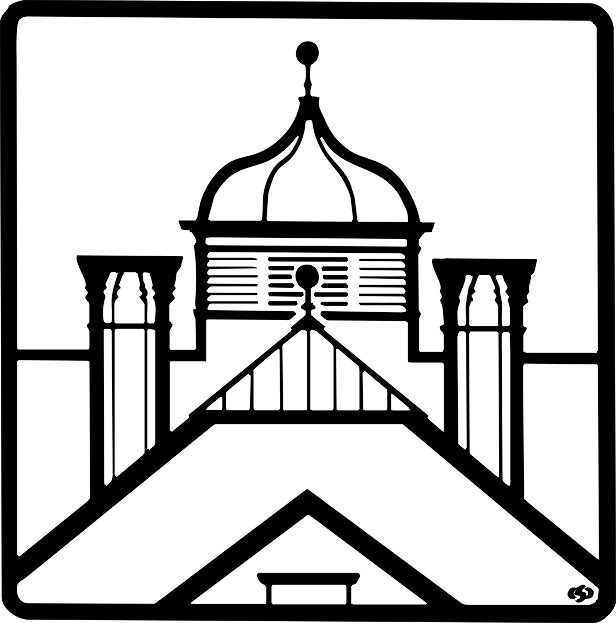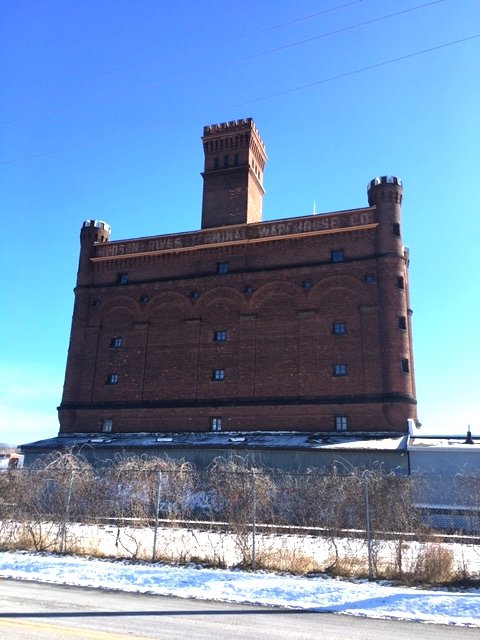Troy’s Fortress of Shoddy
(reprinted from an article by Gateway Board member Suzanne Spellen, and used with her permission)
CLICK ON THE IMAGES ABOVE FOR THE BIG PICTURE
Driving south on Interstate 787, approaching the exit for South Troy, there, across the Hudson, a castle guards the river’s edge like a medieval keep. It’s one of South Troy’s most visible and well-known landmarks. The address is 1 Jackson St. Locals have long called it, appropriately, the “Fortress.” Although it looks much older, the Fortress was completed in 1902 for the United Waste Manufacturing Co. The company headquarters and main factory were in Cohoes. The Troy building was both a warehouse and a large advertisement for the strength and importance of the company.
The United Waste Manufacturing Co. was a major producer of “shoddy.” Shoddy is a cloth made from reconstituted wool and cotton waste material. Long before recycling and reconstituting materials became popular in the late 20th century, mid-19th century manufacturers had figured out how to turn old clothes, rags, scraps, and leftover manufacturing remnants into new products.
Shoddy was used to make padding, workmen’s clothing, and notoriously, soldier’s uniforms. Many of the uniforms of the Union Army during the Civil War were made of shoddy, a practice that continued until World War I. Shoddy was not a superior material; it did not have the strength of either good wool or cotton.Not surprisingly, there was a great deal of complaining, especially during the Civil War, about the quality of the uniforms. The adjective “shoddy,” meaning inferior and badly made, comes from this fabric.
Troy’s garment industries generated lots of fabric waste and provided much of the raw materials for local shoddy manufacturers. Shoddy was a small, but lucrative industry. The United Waste Manufacturing Co., founded in 1899, had over 130 workers by 1906. In addition to operations in Cohoes and Troy, they had an office in Boston and one on Leonard Street in lower Manhattan. Another principal shoddy manufacturer in Troy was the Troy Waste Manufacturing Co. at 444 River St.
Producing shoddy was hard and hazardous work for the factory workers. The rags were soaked in muriatic acid and then dried at temperatures above 100 degrees, which reduced the cotton fibers to carbon. The whole mass was then mixed and oiled, and then ground into a fibrous mass. From this soup, threads were twisted out, and woven into fabric that looked like dyed wool. As can be imagined, this was toxic to workers and respiratory conditions similar to white lung were common.
Fire was a danger as well. This warehouse had a horrific fire in 1908, when worker Ann Rumnick’s dress caught fire from machinery sparks in a baling room where the rags were bundled. The fire spread quickly in the hot, dusty room filled with flammable rags. According to news reports, women jumped out of the second story windows to escape the fire. Fortunately, the sprinkler system and the fire department were able to put the blaze out. Poor Ann Rumnick died, burned beyond recognition, but she was the only fatality. The fire caused over $50,000 in damages, and probably hastened the company’s demise.
United Waste was owned by a group of prominent local investors. The general manager was Edward J. Murphy, former U.S senator (1883-89) and Troy mayor (1875-83). His son Joseph was the treasurer. The vice president was Col. William H. Rowe, Jr, who was an office holder in several local knitting mills, a bank director, and a trustee of Syracuse University. By 1906, the president of the company was J.J. Ryan. He and Murphy had been responsible for the construction of this warehouse, and for the opening of the Waste and Shoddy Exchange, where materials were bought and traded.
Shoddy’s days as a lucrative material were coming to an end by the start of World War I. Although the idea of recycling fabric and scrap was a good one, the resulting material was ,well, shoddy. The name itself and its reputation prevented its use for anything other than a very limited market.
Attempts to use it for soldier’s uniforms during World War I were met with fierce opposition by the armed forces and the soldiers themselves. Uniform suppliers would testify before Congress that soldiers were being asked to fight a war in Europe’s winters; the least the country could do is supply them with real quality woolen clothing, not shoddy. That spelled the end of the industry in that form.
By that time, the United Waste Management Co. had sold the Fortress. It was now the Hudson River Warehouse Co., owned by the same Joseph J. Murphy, who was treasurer of both United Waste and Hudson River Terminal. They were using it as a warehouse, and painted the company name prominently on the building (the lettering is still visible). By 1955, this massive warehouse stored materials for the Goldberg Building Material Corp., part of a larger compound of surrounding buildings.
The warehouse is a six-story brick building with a basement, designed in the Romanesque Revival style of architecture, long favored for armories, storage facilities, and other large buildings that needed strong, sturdy massing to achieve their functional and design objectives. The Jackson St. approach leads to the back of the building. The building’s front faces the Hudson River and has the most architectural detail.
All four sides of the building are flanked with corner turrets that rise from corbelled bases on the second floor, making the building look as if it is top-heavy, sitting on a smaller base, and just asking for a surrounding moat. The tower that rises from the center of the building completes the look of a medieval fortress and held the water tank for the fire sprinkler system. There are windows on every level, but this was a warehouse, not a factory, so there really aren’t all that many, considering the size of the structure. It must have been quite dark, and incredibly hot and stifling in the summer.
The interior of the building is unfinished warehouse space. Huge wooden beams and posts support the ceilings and floors. The basement level consists of large arched corridors that support and spread the load of this massive building. The first floor once was office space, and traces of those days still remain. There is a relatively small spiral staircase that runs the height of the entire building, and a freight elevator. There is also an interior staircase that connects the building’s floors.
In 2007, the building was sold to Maurice Margulies and his wife, Antonie Reinhard, antiques dealers from New York City. Their business, appropriately named Fortress Antiques, features high-end and rare European antiques. They can be found on 1stdibs.com, and a perusal of their goods show vignettes that were photographed to great advantage in the bare interior of the Fortress.
Many of Troy’s industrial buildings have been lost in the last 100 years, but some, like the Fortress, were just too big, or too out of the way, and escaped urban renewal efforts. The Fortress is a survivor. Shoddy may have been this building’s raison d'être, but it was never shoddy. Long may it stand.




